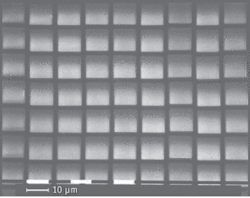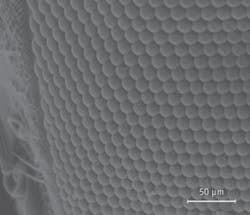Discovery of the structure of a lobster’s eye grabbed the attention of Michael Land of the University of Sussex in England in the 1970s–and inspired a new range of optical designs.
Lobsters’ eyes–and those of shrimp, crayfish, and a few other animals–include arrays of channels that reflect light from a wide range of angles to one spot of focus (see www.laserfocusworld.com/articles/311580). In other words, a lobster’s eye provides a very wide field of view. “A lobster lives in turbid waters and must see the whole hemisphere above it, and with good light-gathering optics,” says George Fraser, director of the University of Leicester’s Space Research Center.
In 1979, Roger Angel of the University of Arizona wondered if Land’s findings might be transformed into a lobster-eye-like device that could “see” x-rays. A wide-angle instrument that captures x-rays would be very useful in astronomy, because the sky produces lots of varying x-rays emissions, and telescopes–even supposedly wide-angle ones–see only about a degree of the sky at a time. During the 1980s, interest in a lobster-inspired telescope languished. By 1989, however, Keith Nugent and his colleagues at the University of Melbourne and Australia’s Commonwealth Scientific and Industrial Research Organization (CSIRO) revived the idea–even providing a design for such a telescope.
In fact, numerous structures in nature provide ideas for optics. “There are multiple places where we steal from nature,” says Paul Gelsinger-Austin an R&D engineer at Edmund Optics (Barrington, NJ). (See www.bioopticsworld.com/articles/355177). “We get all of our equations from it.”
Lobsters in space
No matter how an astronomer wants to look at x-rays, the device needs to be in space–above the atmosphere, which absorbs the x-rays. So Fraser and his colleagues started designing Lobster-ISS, which was a lobster-inspired x-ray device intended to be used on the International Space Station (ISS).
Fraser and his colleagues developed a device that uses microchannel plates made of glass slivers with millions of microscopic holes in them (see Fig. 1). The holes focus x-rays. This device can grab 1,000 square degrees of the sky at once, and that’s a gigantic view compared to other telescopes grabbing just a degree or so at a time. When asked how much the Lobster-ISS resembles a real lobster’s eye, Fraser says, “absolutely exact.”
It turns out, though, that this lobster won’t fly on the space station, largely because of political reasons: the U.K. contributed funds to the project. Nonetheless, Fraser’s team still hopes to launch a “lobster.” For example, a modified lobster device for x-rays could take off on the European Space Agency’s BepiColombo project, which is a satellite that will survey Mercury. This is scheduled to launch in August 2013.
Moreover, the Leicester team is not alone is turning lobster eyes into devices. Scientists at the Physical Optics (Torrance, CA) are also making reflective devices based on lobster-like arrays of microchannels. They hope to make collections of lenses that grab wavelengths from x-rays to the infrared (IR).
Perspective from pit vipers
Biomimetic optics also intrigued H.D. Wolpert. With a background in physics and optics, he started Bio-Optics (Los Angeles, CA) to pursue his interest in animal optics. As Wolpert explains, “I’ve been pretty much a generalist–never able to stick to one discipline. I find multidisciplines extremely fascinating.”
About half a dozen years ago, Wolpert worked on a project to develop improved uncooled IR detectors. To find a better design, Wolpert and a team at the University of Texas suggested studying pit vipers and boids–poisonous snakes that use pit organs, or IR detectors, to sense the heat of potential prey. Although Wolpert believes that the vipers could probably offer some IR-detector advances–like room-temperature operation and making multifunction sensors, such as one that detects the visible and IR–no one knows just how these snakes do it.
Even one conversation with Wolpert, though, suggests that he sees new optical opportunities in every animal. In the moth eye, for example, Wolpert imagines new approaches to antireflective coatings. “You can replicate the surface in, say, fused silica with no manmade coating–just the structure found in a moth’s eye–and you get antireflection.” He adds, “With fused silica, you have one of the highest laser-damage threshold devices.”
In many ways, Wolpert thinks of biomimetics as a way to explore more possibilities. “I can take someone’s business,” Wolpert says, “and tell them how nature approaches it. Maybe there’s more than one way to look at things, and looking at nature offers other possibilities that the company many not have thought of.”
Making biomimetics easier
Biomimetics might not get used as often as possible in part because it’s just too difficult to replicate the natural structure. That’s what Raúl J. Martin-Palma of the Universidad Autínoma de Madrid (Spain) and his colleagues wrote in “A novel technique for making highly efficient biomimetic devices,” published by SPIE (http://spie.org/x30352.xml?ArticleID=x30352). These scientists turned to the technique called conformal evaporated film by rotation (CEFR), using the biological structure as a template. With CEFR, Martin-Palma–then on a one-year stay at Pennsylvania State University–and colleagues replicated a fruit fly’s eye (see Fig. 2). They wrote: “There is neither a distortion of the original structure nor any observable new structure created by the replication technique. As the CEFR technique was implemented at low temperature, the spatial features of the eye were preserved during deposition.” In fact, these researchers even show that the replica handles light like a fly’s eye. This research team also used CEFR to replicate the photonic-bandgap structures in a butterfly’s wing.As some of these advances reveal, this field is worth a look. It has even attracted some notable attention over the years. In a 1911 issue of Philosophical Magazine, for instance, Albert Michelson–the American physicist who measured the speed of light with Edward Morley–wrote about optical filters in birds and insects.
You never know what you might find in nature. As Gelsinger-Austin says, “We look for models all the time from the natural world. We can’t just sit in a room.”
About the Author
Mike May
Contributing Editor, BioOptics World
Mike May writes about instrumentation design and application for BioOptics World. He earned his Ph.D. in neurobiology and behavior from Cornell University and is a member of Sigma Xi: The Scientific Research Society. He has written two books and scores of articles in the field of biomedicine.

